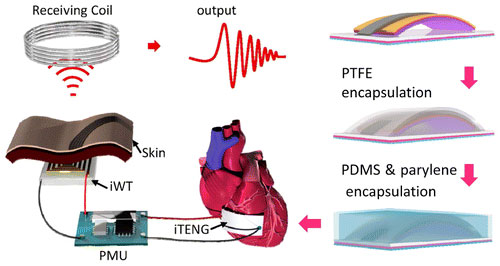| Posted: Jun 07, 2016 |
Nanogenerator powers implantable heart monitor
(Nanowerk News) Implantable electronic devices/systems are crucial medical technologies for monitoring, measuring, and soliciting physiological responses in vivo.
|
|
Over the past decade, the increased in vivo stability, miniaturization, and lower energy requirement of electronics have hugely promoted the applications of physiological signal sensors, intelligent gastric and cardiac pacemakers, cochlear implants, and deep brain stimulators; millions of people rely on such implantable medical devices for improved quality of life.
|
|
However, one of the key challenges for in vivo devices is the battery-based power supply, which has limited energy density, short lifetime, chemical side effects, and a large volume. A surgery is unavoidable for replacing the power source, which may cause suffering, risk, and high cost.
|
|
Researchers from the U.S. and China have now demonstrated an implantable triboelectric nanogenerator (iTENG) for in vivo biomechanical energy harvesting, which has a multilayered structure and exhibits outstanding in vivo performance and stability.
|
 |
| A self-powered wireless transmission system was fabricated for real-time wireless cardiac monitoring. Given its outstanding in vivo output and stability, iTENG can be applied not only to power implantable medical devices but also possibly to fabricate a self-powered, wireless healthcare monitoring system. (© ACS)
|
|
Driven by the heartbeat of an adult Yorkshire porcine, the open-circuit voltage can reach up to 14 V, and the corresponding short-circuit current can be as high as 5 µA.
|
|
The team has reported their findings in the June 2, 2016 online edition of ACS Nano ("In Vivo Self-Powered Wireless Cardiac Monitoring via Implantable Triboelectric Nanogenerator").
|
|
Due to its excellent in vivo performance, a self-powered wireless transmission system was fabricated and the electrical signal associated with the in vivo heartbeat was successfully transmitted, showing its feasibility for real-time remote cardiac monitoring.
|
|
This work demonstrates significant progress for iTENG as a power source for implantable medical devices and its great potential for fabricating a self-powered, wireless healthcare monitoring system.
|

